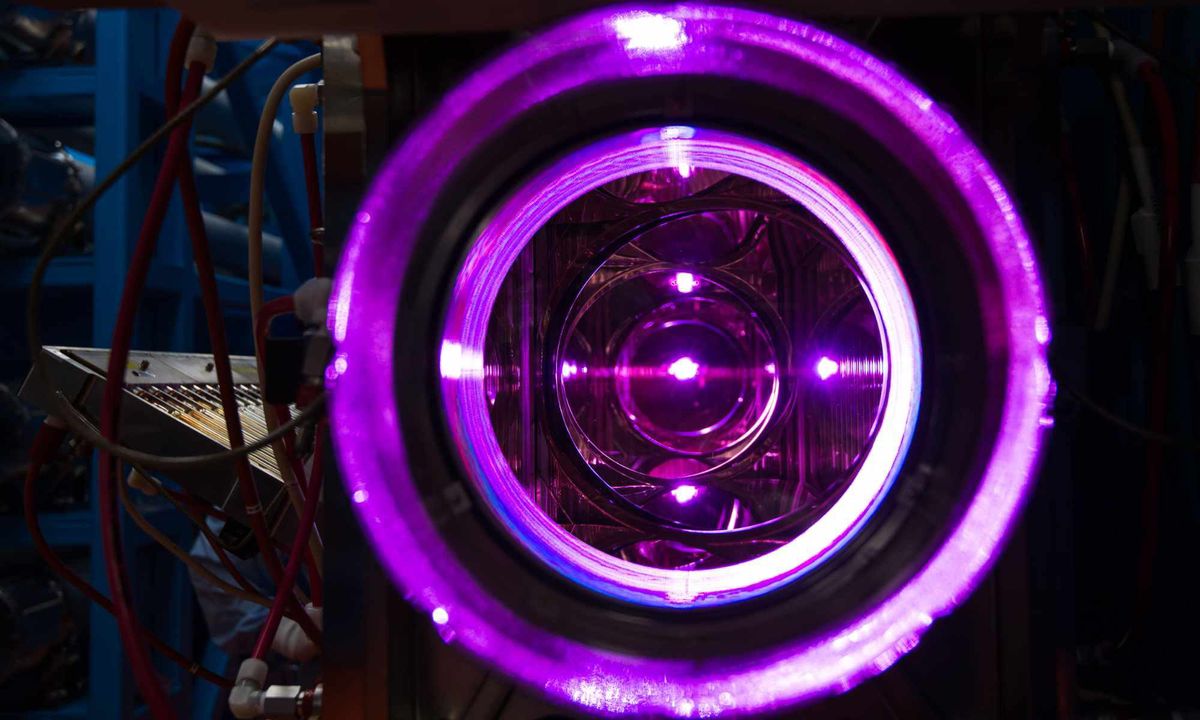Last December, when scientists at Lawrence Livermore National Laboratory’s National Ignition Facility (NIF) achieved a net energy gain—or ignition—in a fusion reactor, you could practically hear champagne being uncorked. The NIF’s discovery was certainly a “necessary first step,” but the eventual possibility of mass-produced fusion still remains far, far away.
All the more reason, then, to celebrate a small but necessary first step for another form of inertial fusion. Researchers from the University of Rochester’s Laboratory for Laser Energetics (LLE) have demonstrated a concept called dynamic shell (DS) formation, which could be used to create cheaper targets for inertial fusion energy.
In a fusion reaction, two lighter atomic nuclei combine to form a heavier nucleus, releasing a large amount of energy. These reactions occur in a plasma, in conditions of extremely high temperature (over 100 million degrees Celsius) and pressure. They also need reliable confinement to sustain the reaction long enough for a net power gain.
The National Ignition Facility’s frozen fuel targets are difficult to make, and each requires days to manufacture. This is a problem, because a fusion plant would need about a million targets a day.
Like the NIF’s vast and widely discussed facility, in the Rochester group’s proof-of-concept system, reactions are initiated by compressing and heating targets using lasers. The targets are tiny pellets filled with fuel, which is usually made up of the hydrogen isotopes deuterium (D) and tritium (T). Fusion power is then generated in the fraction of a second before the target is blown apart by the extreme temperatures and density as a result of the compression.
In the DS method, instead of the conventional frozen hydrogen fuel targets used in the NIF, the researchers use liquid targets. These are made up of a wetted-foam capsule into which a droplet of liquid DT fuel is injected. The target is then bombarded by timed laser pulses that first cause a blast wave and then make it expand. The blast wave goes on to form a dense shell with a void at the center, and finally the shell implodes, releasing fusion energy.
“It was not clear if this technique would work in principle,” says colead Igor Igumenshchev, a senior scientist at LLE, “so we did a proof-of-principle experiment [to show] that this evolution is possible, and it is stable enough to proceed to further research.” The researchers used a surrogate foam target of approximately the same density as liquid fuel. The next step, they say, will be to do the experiment with DT fuel, which will be more complicated.
The frozen DT pellets that are conventionally used in inertial confinement fusion (ICF) are difficult to make, and it takes days to produce a single target. This is a problem because a fusion plant would need about a million targets a day. The liquid targets described in the DS technique, however, don’t require the complex cryogenic layering of the frozen ones and are therefore much cheaper and easier to produce.
Another advantage of the DS concept is that you start with a simpler target—just a liquid droplet, says Valeri Goncharov, theory division director at LLE and colead of the project. With lasers, he says, the target is expanded and shaped into a shell with a smoother target surface than that of the NIF system. “We know now that there is nothing from [a] physics point of view that prevents us to go and produce targets that can deliver ignition for power plants right,” he says. “What we need is to efficiently compress the target.”
The drawbacks of the DS formation technique is that it requires long-duration laser pulses that are difficult to produce using today’s laser technology. DS formation also generates laser-plasma interactions. According to Goncharov, “this is the biggest problem right now in ICF—eliminating plasma waves that scatter energy back.” This is something they are working on at LLE, he adds.
They use broadband lasers, which, rather than being of a single wavelength, have slight variations of wavelengths and could eliminate the creation of the plasma waves. The challenge is to come up not only with the right laser that couples with the plasma, but one that has high energy uptake efficiency, at least 10 to 15 percent. “If we demonstrate that [a] broadband laser can sufficiently couple energy to the target, that will be a significant step forward,” Goncharov says.
George Tynan of the University of California, San Diego, whose research interests include the plasma physics of controlled nuclear fusion as an energy source, says the experiment delivers a proof-of-concept demonstration of DS. (Tynan wasn’t involved in the LLE study.) “The results in the paper show that the basic plasma production and hydrodynamics needed for the DS concept, at least in principle, work as necessary,” he says. “The next logical step, in my opinion, would be a demonstration of successful DS formation in a foam target that has been infused with liquid DT.”
The Rochester team reported their results in a recent issue of the journal Physical Review Letters.
Payal Dhar (she/they) is a freelance journalist on science, technology, and society. They write about AI, cybersecurity, surveillance, space, online communities, games, and any shiny new technology that catches their eye. You can find and DM Payal on Twitter (@payaldhar).



